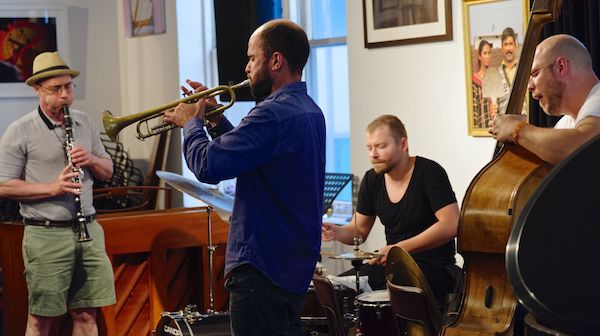Dec 9, 2025 12:28 PM
In Memoriam: Gordon Goodwin, 1954–2025
Gordon Goodwin, an award-winning saxophonist, pianist, bandleader, composer and arranger, died Dec. 8 in Los Angeles.…

American artists Ned Rothenberg (left) and Amir ElSaffar join Polish musicians Michal Bryndal and bassist Ksawery Wójciński for a performance during the Jazztopad festival in New York City.
(Photo: Thomas Andres)Jazztopad is a major Polish festival, with its 15th edition in Wroclaw set for November. For the last three years, a mini-missionary event has been held in New York City, taking over major clubs and theaters with an imported crew of Polish players. This year, Jazztopad presented five days of shows, at Dizzy’s Club Coca-Cola, Joe’s Pub, National Sawdust and the Jazz Gallery, a fairly diverse cross-section of New York City venues.
Titled “The Best Of Polish Jazz,” the series programming certainly displayed a high degree of artistry, with an emphasis on the music’s more adventurous aspects, whether via composition or free improvisation. On June 24, there was an extra performance, a “private” concert at Alwan for the Arts, a cultural organization on Beaver Street, close to Battery Park. This was another unlikely choice of venue, as it’s primarily a home for Middle Eastern sounds. Jazztopad also has a tradition of home concerts as part of its Polish program, and this is another concept that they have transplanted to New York.
The three-group showcase began with Marcin Masecki (upright piano) and Jerzy Rogiewicz (drum set), who took the hoary old form of ragtime and subjected it to a 2017 radicalization. Prime source material includes numbers by Fats Waller, Eubie Blake and James P. Johnson, although not usually in their immediately recognizable state. The duo’s relishing of the clunky player-piano style produced a pertly dancing motion. Rogiewicz’s brushes on an ultra-tiny hi-hat abruptly shunted into a waltzing confection with caressed snare action.
In this minimalist duo configuration, Masecki enjoys a pumping motion in his solos, which themselves are part of the theme. It’s a fairground form of vintage jazz, an emphatic swing caught up in a freely improvising tangle. The pair’s tunes prompted knowing smiles, as well as a sense of wonder at their ability to distort the classic delivery. It’s the most absurdist jazz we’ve heard in a long while!
The piano trio Stryjo played next, with drummer Michal Bryndal draping cloth on his snare, using soft mallets to enter a secluded universe of quiet. Bassist Maciej Leszczynski played completely acoustically, while pianist Nikola Kolodziejczyk had slung a laptop under his lid, controlled by a small fader-box. His alterations were subtle in volume and radical in nature, involving spacey echoes and hard-noted repeats, circulating endlessly. He preferred an open, resonant feel, with the occasional key-muting via direct contact with the piano strings. But the electronics maintained a cautious character through low volume usage, even when the output was becoming quite extreme in its content. Stryjo adopted a lyrical form of improvisation, concerned with melodic tone and organic texture, although by the close of their set, increasing fragmentation began to break up the melodic heart.
The Wójcinski/Szmanda Quartet (formed just two years ago) completed the lineup of this afternoon session. Maurycy Wójcinski’s muted trumpet and Ksawery Wójcinski’s bowed bass began with a tentative probing, gradually growing into a funkified lope before calling a few sudden halts to their race and leaping off again. Each band member set off small explosions in a relay of expression: the bass walked with a head-banging toughness, Szymon Wójcinski’s piano flowed, Maurycy’s trumpet scribbled and Krzysztof Szmanda’s drums crashed out their punctuation parts. (And yes, this quartet features three brothers named Wójcinski.)
To conclude, a Polish-New York supergroup was convened, with Ned Rothenberg (clarinet) and Amir ElSaffar (trumpet) fronting a combination of Stryjo and the Wójcinski/Szmanda Quartet, both drummers joining, with Bryndal adopting a percussion role.
Everyone bonded together successfully, as the horn pair set up long, keening tones, held static as the drummers worked out their tiny details. Rothenberg produced a circular cycle, and ElSaffar muted with his fingers. Kolodziejczyk’s electroacoustic piano twinkled as a sparse march evolved, subtly led by a hand-held small drum, tiny bells and a pair of shakers. The horns trilled in unison, across an insistent snare-and-cymbal repeat, Rothenberg repeating a phrase whilst ElSaffar sustained his note, in a fanfare fashion. This impromptu outfit’s roles of repeat and ornamentation shifted their relationships as this inspired improvisation unwound.
Hopefully, the Jazztopad roadshow will return to NYC once again next year. DB

Goodwin was one of the most acclaimed, successful and influential jazz musicians of his generation.
Dec 9, 2025 12:28 PM
Gordon Goodwin, an award-winning saxophonist, pianist, bandleader, composer and arranger, died Dec. 8 in Los Angeles.…

Flea has returned to his first instrument — the trumpet — and assembled a dream band of jazz musicians to record a new album.
Dec 2, 2025 2:01 AM
After a nearly five-decade career as one of his generation’s defining rock bassists, Flea has returned to his first…

Belá Fleck during an interview with Fredrika Whitfield on CNN.
Jan 13, 2026 2:09 PM
The fallout from the renaming of the John F. Kennedy Center for the Performing Arts to include President Donald…

“It’s a pleasure and an honor to interpret the music of Oscar Peterson in his native city,” said Jim Doxas in regard to celebrating the Canadian legend. “He traveled the world, but never forgot Montreal.”
Nov 18, 2025 12:16 PM
In the pantheon of jazz luminaries, few shine as brightly, or swing as hard, as Oscar Peterson. A century ago, a…

Dec 11, 2025 11:00 AM
DownBeat presents a complete list of the 4-, 4½- and 5-star albums from 2025 in one convenient package. It’s a great…